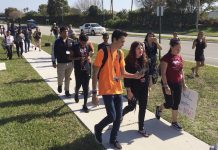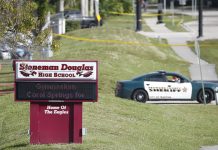
PARKLAND, Fla. (AP) — About 50 uniformed police officers marched into Marjory Stoneman Douglas High School early Wednesday as classes resumed for the first time since 17 students and teachers were killed by an expelled classmate with an AR-15, thrusting them into the center of the nation’s gun debate.
Grief counselors are on campus as well “to provide a lot of love, a lot of understanding” and help students “ease back” into their school routines, Broward Schools Superintendent Robert Runcie said.
A long line of cars circled the school and dozens of television trucks and vehicles were camped out nearby as students, parents, and staff were ushered through a security cordon.
A banner “Welcome Back Eagles” sign covers the main entrance, and the walkway leading onto the campus was lined with flowers, photographs and other memorials to the those killed. Some of the students were returning despite severe gun wounds, but even those who weren’t hit by bullets spoke of emotional trauma.
Alexis Grogan, a 15-year-old sophomore, planned to wear a Stoneman Douglas color — maroon — on the first day back to class Wednesday, plus sneakers that say “MSD Strong, be positive, be passionate, be proud to be an eagle” and “2/14/18″ in honor of those who died.
She feels nervous like it might be too soon to go on as usual without slain friends like Luke Hoyer, who sat two seats behind her in Spanish. Still, the support from her fellow students and their fight to strengthen gun control laws have buoyed her spirits.
“I am so proud of how the kids at my school have been fighting because we all want to change to happen and, as we see the progression, it really shows us that people do care and they do hear what we have to say,” Grogan said in a text message.
The Douglas students return to school after a whirlwind of political activism that has reignited the nation’s gun and school-safety debate. Douglas sophomore Charlotte Dixon said some of her friends are having a hard time returning to classes. But like Grogan, they are encouraged by the attention to gun laws their actions have brought.
“I’m so glad that people are stepping forward and talking about keeping it relevant … because it shouldn’t happen to anyone ever again,” Dixon said.
On Tuesday, relatives of the Stoneman Douglas victims kept up the pressure in Florida’s capital with emotional testimony during a legislative hearing to discuss passing a bill that would, among other things, raise the age limit to buy long guns from 18 to 21. The bill also would create a program that allows teachers who receive law-enforcement training and are deputized by the local sheriff’s office to carry concealed weapons in the classroom, if also approved by the school district. The school’s superintendent has spoken out firmly against that measure.
The House Appropriations Committee’s 23-6 vote in favor of the bill Tuesday followed more than four hours of emotional discussion with the parents of some of the 17 killed, and nearly two weeks of activism by students on social media and in televised debates.
Gov. Rick Scott, who met with officials in Miami-Dade County on Tuesday, said at a news conference that he hopes a gun and school-safety bill is passed before Florida’s annual legislative session ends on March 9. He had proposed measures that overlap with the Legislature’s plan but did not include arming teachers. However, he declined to say Tuesday whether he would veto the sweeping package if it included that provision.
The Senate’s version of the school-safety bill was approved by a second committee on a 13-7 vote Tuesday evening. Sen. Bill Galvano, who is designated to become the next Senate president and is ushering in the bill, said the earliest it will be considered by the full Senate is Friday.
Marion Hammer, a lobbyist for the National Rifle Association and Unified Sportsmen of Florida, told the House Appropriations Committee that she supports tightening school security and keeping guns out of the hands of the mentally ill, but not the House bill’s gun-ownership restrictions, which she later said would not have stopped the Parkland shooting.
“Part of what we need to do is make people understand that guns are not the problem,” she said after the hearing. “So passing more laws dealing with guns as a solution to a problem that exists within the enforcement of laws is just kind of silly.”
Max Schachter, the father of 14-year-old victim Alex Schachter, said the bill the House committee eventually approved doesn’t go far enough — but could have saved his son.
“If we would have had these measures in place, I would not have had to bury my son next to his mother a week and a half ago. … I’m pleading for your help. I’m willing to compromise. Are you?” he asked.
Outside the school on Tuesday, people tied poems to the chain-link fence surrounding the school and dropped off red heart-shaped balloons. The building where the shooting occurred was cordoned off, and people signed photographs of the fallen.
Junior Sidney Fischer, 17, was in a Holocaust history class when the shooter aimed his gun at the window and shot into the room. Two students in his classroom died. He’s planning to wear swim goggles on his first day back Wednesday to honor his friend Nicholas Dworet, who was an accomplished swimmer.
“Obviously our school will never be the same, but I think once we get back into our normal routine people will shift back into a comfortable state,” Fischer said.
He’s planning to ride to school with a friend — just like they did before the shooting.
“I’m actually not too scared of going back tomorrow,” he said. “There is this sort of looming thought that someone will try to perform another shooting but I’m sure our school will be riddled with security.”
___
Associated Press writers Brendan Farrington in Tallahassee and Curt Anderson in Miami contributed to this report.













